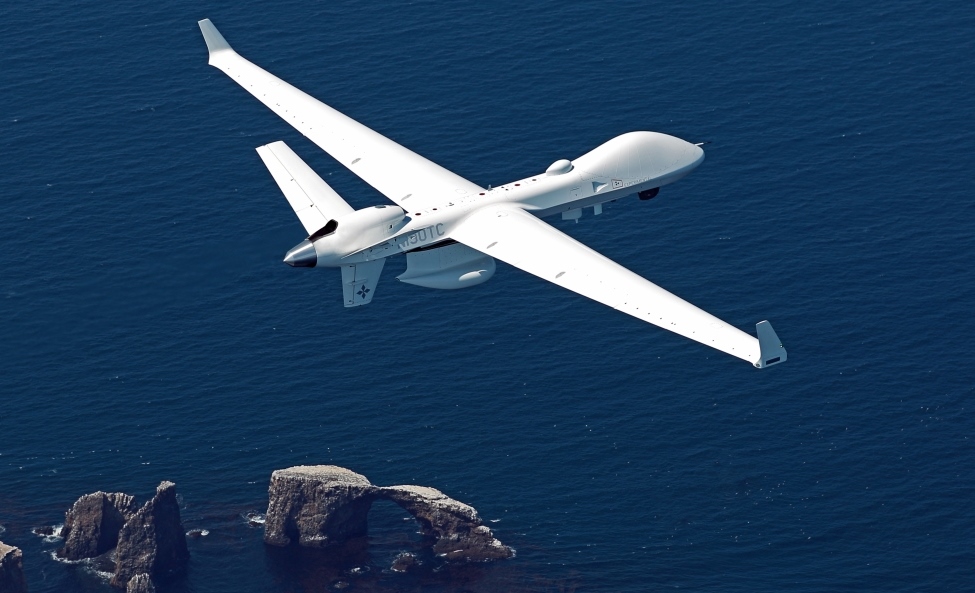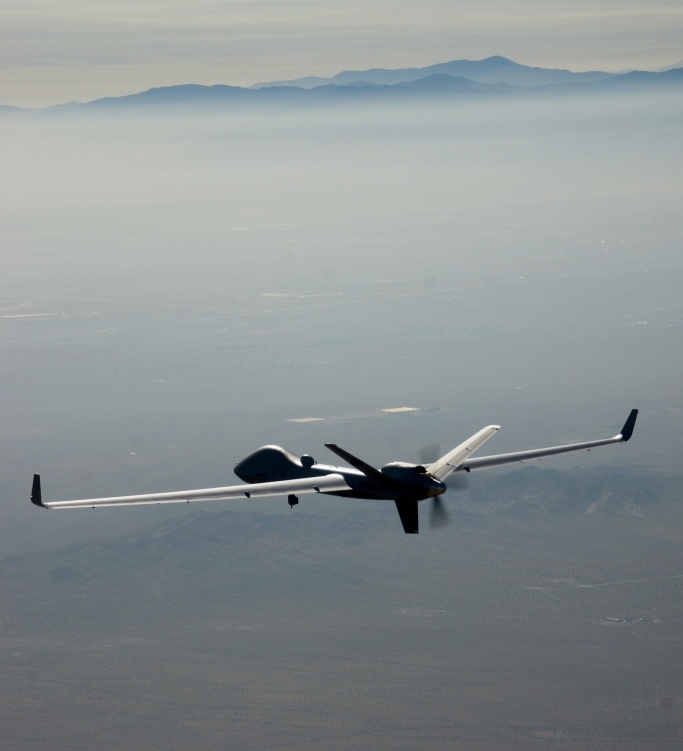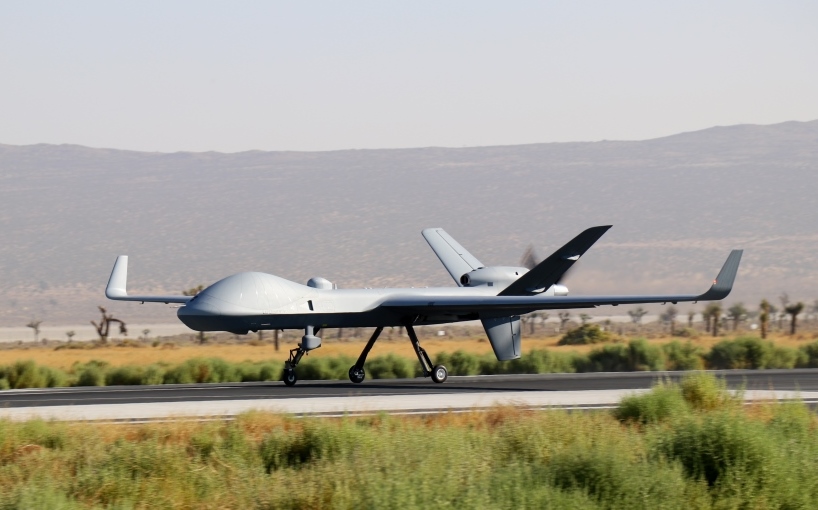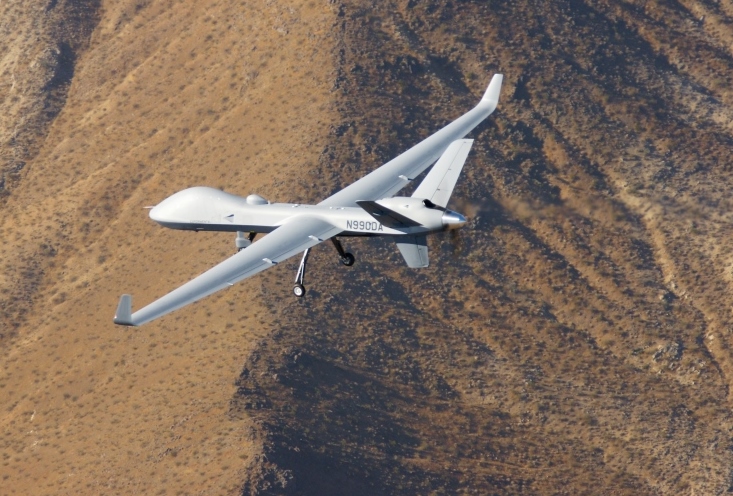TEAM SKYGUARDIAN CANADA
BY JOETEY ATTARIWALA
Team SkyGuardian Canada
Leveraging Canadian Technology for RPAS
 As a solution for Canada’s Remotely Piloted Aircraft System (RPAS) Project, Team SkyGuardian Canada has been put together to propose the world’s most advanced RPAS – the MQ-9B SkyGuardian.
As a solution for Canada’s Remotely Piloted Aircraft System (RPAS) Project, Team SkyGuardian Canada has been put together to propose the world’s most advanced RPAS – the MQ-9B SkyGuardian.
With SkyGuardian’s unique ability to operate in non-segregated airspace, in addition to it being the only RPAS interoperable with Canada’s closest allies - NORAD, FVEY and NATO – it makes this system an ideal solution for the Canadian Armed Forces (CAF) critical national security missions, from coast-to-coast-to-coast.
Since 2018, Team SkyGuardian has been pulling together experts from a selection of Canadian companies and that has resulted in the formation of an industry team that will be able to innovate and deliver advanced Remote Piloted Aircraft (RPA) solutions for Canada and also the world. Team SkyGuardian members include General Atomics Aeronautical Systems Inc. (GA-ASI), and Canadian industry leaders CAE, L3Harris Technologies and MDA Corporation.
But, be assured, this is a team in the true sense of that word because its members have demonstrated a strong collaborative spirit that will allow it to continue spearheading technological advancements and growing Canadian capability in the “unmanned” realm where a network of over 2,000 Canadian-owned companies will shape the future of Canada’s defence industrial complex.
A WORLD LEADER IN UAS SYSTEMS
If selected for RPAS, the MQ-9B SkyGuardian would be equipped and ready to operate with the best Canadian capabilities due to its successful industrial collaboration efforts. “GA-ASI is always looking to build on our existing Canadian industry relationships,” Linden Blue, CEO, GA-ASI, told CDR.
“A strong North American industrial partnership contributes to the growth and success of our domestic and international endeavors. Team SkyGuardian Canada is aimed at building long-term relationships that advance Remotely Piloted Systems and Autonomous Technologies and developing sustainable jobs in Canada.
CAE IS A LEADER IN TRAINING SYSTEMS
With over 70 years of operation, Team SkyGuardian partner, CAE, brings a critical capability and expertise to the group. This full-service defence company headquartered in Canada and it employs approximately 10,000 people worldwide – 4,500 of which call Canada home. As a leading training systems integrator, CAE Canada focuses on two key capability areas: Training and Simulation, and Operational Systems and Support. So, it is because of this company’s capability and reputation that GA-ASI sought out CAE for a global training relationship.
“We look forward to expanding our team of experienced Canadian partners,” France Hébert, Vice President and General Manager, CAE Canada, told CDR. “Our objective as the lead partner for training and in-service support is to engage Canadian industry to solidify Team SkyGuardian and help grow the defence and aerospace sector across the country.”
She added, “As a company based in Canada, CAE already supports a large network of suppliers across Canada which will contribute to making the Team SkyGuardian remotely piloted aircraft system the right choice for the RCAF and Canadian industry.”
CAE is highly regarded for the RPA training systems and services that they have developed for militaries around the world. Examples of programs that CAE is delivering include a zero flight time Predator Mission Trainer for the Italian Air Force; the ongoing development of a synthetic training system for the Royal Air Force’s Protector program; and the delivery of a comprehensive training system to the UAE Air Force which includes academic, simulator and live-fly RPA instruction.
“We understand that there is really nothing unmanned about these critical systems because they all require proficient and trained individuals and professionals to operate them and deliver combat capability,” said Jim Chittenden, Director of Strategy and Market Development for Unmanned Systems at CAE.
He told CDR, “We are focused on integrating big data, virtual and augmented reality, advanced learning algorithms and artificial intelligence into existing products while developing new and innovative ways to train in a multi-domain unmanned environment. For example, our MQ-9 Predator Mission Trainer has realized such a high degree of fidelity that both the flight model and the aircraft’s sensors of the simulator were certified as Level D equivalent, the highest qualification for flight simulators, and the first and only RPA simulator ever to achieve this level of accreditation.’’
MDA IS A LEADER IN SURVEILLANCE AND IMAGING
MDA’s leading intelligence solutions take on a significant role within the team, as they continue to help shape a more secure world and enable the Canadian Armed Forces to respond to the challenges of today and tomorrow. MDA has successfully exported its made-in-Canada solutions for more than four decades and is committed to delivering innovation and value in next-generation space exploration, Earth observation, space awareness, and defence systems.
“Key to our success is our partnerships with innovative small and medium-sized businesses,” said Mike Greenley, Chief Executive Officer of MDA. He told CDR, “We look forward to working with high quality Canadian partners in the areas of image exploitation, communications, new sensor payloads, and airborne data processing as part of Team SkyGuardian.”
L3HARRIS SENSOR SYSTEMS
Rounding out the principle Team SkyGuardian members is L3Harris’ WESCAM division, located in Burlington, Ontario. WESCAM is a world-leading manufacturer of Electro-Optical Infrared (EO/IR) Sensor Systems and an integral member of the team. WESCAM’s MX-20 EO/IR system is equipped with high-sensitivity multi-spectral sensors for day, low light and nighttime missions, and was first integrated onto an MQ-9 in March 2020.
“The GA-ASI and L3Harris teams have worked closely over the past year to ensure the successful integration of this sophisticated system,” said Linden Blue. “This is a significant milestone and we look forward to the enduring relationship and growing opportunities with L3Harris WESCAM.”
Jacques Comtois is General Manager, L3Harris WESCAM and he told CDR, “L3Harris is proud to partner with GA-ASI to deliver sophisticated technologies for persistent surveillance missions and evolving battlefields… Being a Team SkyGuardian Canada partner allows us to support our technology’s modular growth path with unprecedented levels of innovation and business opportunities globally for leading unmanned aircraft system programs.”
Adding to those remarks was Cameron McKenzie, Vice President of Global Business Development and Sales for L3Harris WESCAM who said, “We have already seen first-hand TSGC’s benefit to our global business and would encourage other Canadian companies to become part of the team directly via L3Harris’ WESCAM division or any of the other partners’ supply chain.”
BUILDING LONG-TERM RELATIONSHIPS
Team SkyGuardian is focused on building long-term relationships that advance Remotely Piloted Systems and Autonomous Technologies (RPS-AT) and develop high-quality sustainable jobs in Canada across the aerospace and defence sectors.
In August 2020, GA-ASI announced its second annual Strategic Industry Engagements initiative with the goal to expand its business-to-business cooperation efforts with Canadian industry. Companies with proven aerospace and defence capabilities were encouraged to apply for potential business opportunities within GA-ASI’s MQ-9B RPA Program. Businesses small to large with technologies in the following area were considered: Aircraft Operations & Maintenance (O&M); Sensor Data Processing, Exploitation and Dissemination (PED); Airborne Sensors/Payloads; Global Supply Chain for aircraft components and manufacturing; and Research and Development (R&D) related projects for Unmanned Aircraft Systems.
GA-ASI continues to be at the forefront of pioneering RPA solutions. In 2014, the company internally funded a program to develop MQ-9B SkyGuardian, which adds several key enhancements to the proven MQ-9 series allowing for better performance, lower operating and sustainment costs and access to all classes of airspace. The first “Type-Certifiable” MQ-9B took flight in November 2016. It went on to set a GA-ASI RPA Endurance Record of 48.2 hours in May 2017. The SkyGuardian was also the first MALE RPA to complete a trans-Atlantic flight in July 2018.
AN EVOLUTION OF THE PREDATOR B
The SkyGuardian meets the NATO STANAG-4671 compliant type certifiable design, and in cooperation with the FAA, meets airworthiness certification standards in the United States and around the world. It leverages both the Predator B RPA and Certifiable Ground Control Station (CGCS) as points-of-departure systems and identifies and incorporates the changes needed to achieve a Type Certifiable system.
The MQ-9B contains both hardware and software upgrades, such as improved structural fatigue and damage tolerance and more robust flight control software, as well as enhancements allowing operations in adverse weather including icing conditions. Additionally, the aircraft will be designed to survive bird and lightning strikes. The platform is highly modular and is easily configured with a variety of payloads to meet mission requirements. The aircraft is capable of carrying multiple mission payloads and includes GA-ASI’s state-of-the art Detect and Avoid (DAA) system including space, weight, and power provisions to enable the retrofitting of an airborne Due Regard Radar (DRR) for operation in non-cooperative airspace.
Colonel (Ret) Scott Campbell, a former Wing Commander and MQ-9 Reaper operator with the U.S. Air Force, told CDR, “What’s interesting about the MQ-9B SkyGuardian is it’s a structural upgrade to the MQ-9, not just an avionics upgrade. The original Predator, and the Reaper that followed, were quite sensitive to weather so we had to limit operations when weather was questionable.”
He explained, “The SkyGuardian resolves those issues with stronger skin, de-ice and anti-ice, so now you’ve really opened up the environment they can operate in. In Canada, you’d be operating these aircraft in the Arctic - an area of huge concern not only for Canada but for others as well, particularly as sea lanes start to open up as ice recedes. So I think the ability to have TCAS, ADS-B, and IFF to operate in the national airspace construct is huge because that has traditionally been such a problem because we have to do a lot of work to deconflict the airspace with a sanitized corridor just to move aircraft from point A to point B.”
Campbell added, “With the SkyGuardian, not only can you move them around like any other aircraft, but you can also use them in the national airspace structure. The other obvious advantages are they have more hard points, a larger payload, and auto-takeoff and land - all great points. For me as an operator, the SkyGuardian is the most significant leap in technology and capability for this class of RPA.”
GAME CHANGING CAPABILITY
Another game changing capability that the SkyGuardian delivers is automatic takeoff and landing capability (ATLC). Speaking to this, Colonel Campbell said, “The auto-takeoff and land system is a significant development for a couple of reasons. First, it significantly reduces the manpower bill, particularly when you are conducting forward-based or deployed operations. Normally, it takes at least 3-4 crews to fly a mission because you require a standalone crew with line-of-sight communication with the aircraft to launch and recover it. While it does not obviate the need for maintenance ground crews, it really reduces the aircrew requirement.”
He explained, “The other advantage is we're likely to see a reduction in mishaps in the landing phase. The advances in the MQ-9B should lead to higher aircraft availability/mission capable rates.”
The Royal Air Force was the very first to acquire the SkyGuardian - referred to as Protector by the British acquisition program - as a replacement for its Reaper fleet. MQ-9B SkyGuardian is the world’s most advanced multi-role RPA that meets Canada’s strategic vision and primary missions in Strong, Secure, Engaged. It provides advanced intelligence, surveillance, target acquisition, and reconnaissance (ISTAR) and precision effects in support of CAF commanders, critical domestic security and deployed expeditionary operations.
It is designed to operate within the multi-domain spectrum. The SkyGuardian provides cutting-edge Air, Sea and Land Intelligence, Surveillance and Reconnaissance (ISR) capabilities to carry out complex mission roles at a moment’s notice to help protect Canadian territory and support allies around the world. Some of those complex missions include anti-submarine warfare, anti-surface warfare and strike and electronic warfare. It also has the ability to network with other air, sea, land and space systems delivering exceptional interoperability for an allied or joint force effort and thus further contributing to the success of the Canadian Armed Forces at home and abroad.
GREATER PAYLOAD
“The MQ-9B SkyGuardian is our newest aircraft so it brings new capabilities to our customers. Its greater payload capability, longer endurance, and access to all classes of airspace open up the potential for completely new mission sets beyond the well-known military applications of these systems,” explained Linden Blue.
GA-ASI is increasingly seeing its customers interested in using these systems to support civil governmental missions such as disaster response, maritime security, border protection, and security for large events. Their RPA have provided security oversight of large Summit meetings, and have done airspace and sensor testing for NASA.
They have also been used in counter-piracy operations and, with the increased range and endurance, have shown great utility in the Economic Exclusion Zone [EEZ] and fisheries monitoring over the Pacific. “Overall, we are seeing a large expansion in types and numbers of missions these aircraft are successfully executing,” Blue said.
Canada’s geographic location presents a unique set of security needs that require a significant amount of manpower and assets. These needs should be addressed by a multi-role platform - like the MQ-9B - that would be an invaluable asset for persistent, reliable and cost-effective situational awareness.
For example, Canada is one of the most forested countries in the world with 34.8% of its region covered by forestland, according to the State of Canada’s Forest Report. The National Forestry Database reports that about 8,000 fires occur each year throughout Canada. The endurance and ISR capabilities allow the MQ-9B to cover this extensive territory. In such instances it can detect areas at risk for prevention and in the event of a fire, civil authorities and firefighters could employ MQ-9B’s real-time data feed transmitted to them via satellite to monitor spread, track hot spots and fire lines.
MULTI-ROLE PLATFORM
In response to this increasingly important mission, MQ-9 RPAs support California’s Air National Guard every year during the fire season. It is here where the MQ-9’s high-definition, full-motion video (optical and infrared) and ground imaging Synthetic Aperture Radar give a clear big picture, including identifying small changes that can make a difference in containing fires.
Another important mission well suited for the MQ-9B is Search and Rescue (SAR) - a no-fail mission in Canada that requires immediate action with little room for error. There is no doubt that a persistent presence that reinforces or replaces human scanning will accelerate the SAR response time, contributing to the success of missions overall. The MQ-9B can stay aloft for periods of over 40 hours and navigate complex terrains with adverse weather conditions like the Arctic, or survey the aftermath of natural disasters so first responders can quickly understand the situation and save lives.
In September, GA-ASI conducted a set of over water test flights off the coast of Southern California using the MQ-9B maritime variant, MQ-9B SeaGuardian RPA. This was the first MQ-9B SeaGuardian test flight over open-water. The Southern California test flight demonstrated how SeaGuardian can be used for a variety of maritime missions, including surface search, subsurface search, coastal surveillance, anti-piracy and search and rescue.
The aircraft onboard sensors included the GA-ASI Lynx Synthetic Aperture Radar, a Raytheon Intelligence & Space SeaVue Expanded Mission Capability (XMC) radar, a Raytheon Intelligence & Space Multi-Spectral Targeting System, a Leonardo Electronic Support Measure (ESM)/Electronic Intelligence (ELINT) SAGE 750, a Shine Micro Automatic Identification System (AIS), an Ultra sonobuoy receiver and a General Dynamics Mission Systems-Canada sonobuoy processor.
INTEROPERABILITY WITH NORAD, FVEY & NATO
Team SkyGuardian Canada’s proposed solution to Canada’s RPAS Program is the world’s most advanced RPAS – MQ-9B SkyGuardian. Its unique ability to operate in non-segregated airspace, in addition to being the only RPAS interoperable with Canada’s closest allies, NORAD, FVEY and NATO, make it the ideal solution for the Canadian Armed Forces. GA-ASI continues to be at the forefront of pioneering RPA solutions and because of our partnerships, MQ-9B is equipped and ready to operate with the best Canadian capabilities.
The MQ-9B SkyGuardian continues to gain interest from many countries. GA-ASI is currently partnering with Asia Air Survey (AAS) to conduct a series of validation flights for the Japan Coast Guard (JCG) featuring GA-ASI’s MQ-9B SeaGuardian. The flights will validate the wide-area maritime surveillance capabilities of RPAS for carrying out JCG’s missions, including search and rescue, disaster response, and maritime law enforcement.
In Australia, GA-ASI was selected to provide MQ-9B SkyGuardian for the Armed RPAS capability for the Australian Defence Force (ADF) Project Air 7003. GA‑ASI announced that the industry team assembled for the development and delivery of SkyGuardian for Australia will now be called “Team SkyGuardian Australia” (TSGA), which consists of 10 world-class companies including CAE.
GA-ASI, by way of the United States Government, has recently signed a Foreign Military Sales contract with the Belgian Ministry of Defense where that country will acquire the MQ-9B SkyGuardian. The contract covers the design, development, integration and production of the RPAS with its EO/IR video and SAR/GMTI surveillance payloads, as well as a Certifiable Ground Control Stations (CGCS), Portable Pre-Flight/Post-Flight Equipment (P3E), ground support equipment and spares. The first delivery is expected in 2023.
In July, GA-ASI signed a contract with the UK Ministry of Defence (MoD) for the manufacturing and delivery of the Protector RG Mk1 RPAS. The first MQ-9B in the Protector configuration was completed in September. The MQ-9B SkyGuardian is the baseline system that will become the Protector when configured for the Royal Air Force. This configuration includes X-band satellite communications (SATCOM) and UK weapon systems. The contract covers a total of 16 aircraft (initial order of three platforms with an option for an additional 13) and seven Ground Control Stations (GCS), together with associated ground support equipment. The first production representative system took first flight on 25 September 2020 and will be delivered in 2021, though it will remain in the United States to be utilized in the test and evaluation program.
There is no doubt that Team SkyGuardian is a is a world-class group of companies, its Canadian pedigree notwithstanding, and will offer a very strong solution for the RPAS requirement. In the meantime, the team is looking to increase its collaboration within the aerospace, space, defence and unmanned systems technology sectors in Canada that would see significant technological and economic growth in this country’s now struggling aerospace sector.
Joetey Attariwala is CDR’s Senior Staff Writer and Aviation Editor

